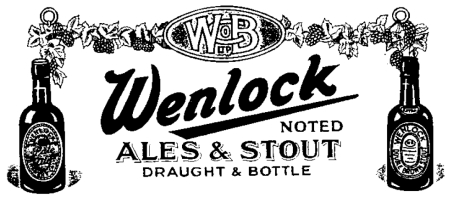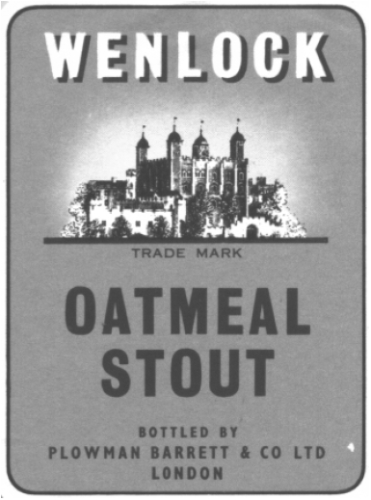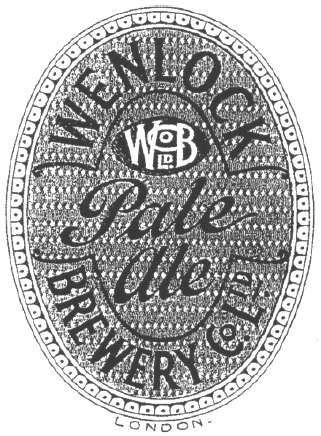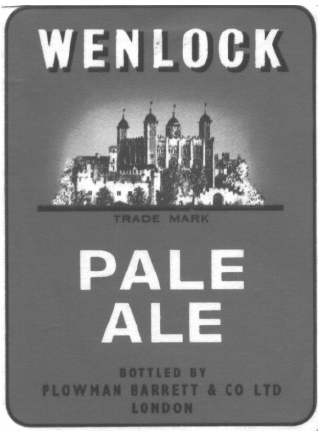
Copyright © 2004 the Brewery History Society
|
Journal Home > Archive > Issue Contents > Brew. Hist., 112, pp. 3-9 |
Terror at Wenlock Brewery |
by Stephen Sadler |
Charles Dickens wrote superb stories, all rich in drama but to add geographical reality to fiction the Victorian author placed imaginary people in venues that actually existed. Thus when young David Copperfield, about to becomes a lodger of Wilkins Micawber, is introduced to this ebullient character, the reader gets taken to a part of Shoreditch (now Hackney). "My address" said Mr Micawber, "is Windsor Terrace, City Road. I -in short," said Mr Micawber with the same genteel air, and another burst of confidence - "I live there".
A drawing of Windsor Terrace, Shoreditch, from that era shows a row of Georgian houses. This is how Dickens would have known the Terrace when he published David Copperfield in 1850. In an age when refurbishment was unheard of those houses never altered. From Dickens day they remained untouched, brick upon brick, and were homes to generations of Londoners. In fact right up to the grim events of the Blitz in World War II.
The Blitz began late summer 1940. By early autumn the ferocity of night bombing increased and so Londoners nightlife fell into a regime of survival. After an evening meal they dressed in warm clothing, took to the air raid shelter for the night - wherever that might be - with a blanket and perhaps a few treasured possessions. In this manner, on the evening of Tuesday 10th September the Pages left their home at 26 Windsor Terrace, for the first time ever, to take refuge in a public air raid shelter: the basement of Wenlock Brewery. The brewery, just at the bottom of the terrace, fronted Micawber Street, a thoroughfare that had acquired that evocative name in the 1930's to commemorate the character created by Charles Dickens.
|
|
 |
|
|
The family consisted of Widow Emma Page, her two daughters Emma Wain and Grace Goudge, both widows of what had been called The Great War. Then came Emma's three adult grandchildren Janette Goudge, Violet Page, and Ted Simmonds. They were just another group seeking sanctuary on that wartime evening. When the 84-year-old Emma Page, flanked by her family, walked slowly along the blacked-out Windsor Terrace she could not have known that for her it would be a one way journey. Destiny decreed that Em would never return to the old house where she had watched her children and grandchildren grow into adults.
The brewery basement, a well-used working area by day, became a communal air raid shelter by night. On that evening several hundred locals sat on benches or lay on make shift beds. In dull lighting a few attempted to read by pocket torches. Some child evacuees had returned to London during the period known as the Phoney War. This is why a few small bodies could be seen bedded down with their families. In this sombre atmosphere Emma Page and her two daughters were found bench seats. The much younger Violet and Janette were nearby seated on the floor. On the far side of the basement, beyond a refrigeration unit, a group of men, including Ted, were in a separate room playing a hand of cards. That part of the basement was considered to be a high risk area.
An air raid took place that night and continued until the early hours of the morning. In the brewery shelter they could hear the nerve wracking screech of bombs whistling through the sky; feel the sickening crump of an explosion and in nervous tension wait for the next cascade of death.
Fearfully the hours dragged on into another day. Just after 4am, 11th September, a series of explosions shook the brewery. The adjacent Wenlock Road School and surrounding houses had been bombed. Debris from those buildings fell into the road and smothered brewery basement doors trapping the occupants inside. Meanwhile, bomb damage in the brewery sent masonry falling on to the refrigeration plant, and caused it to leak ammonia gas throughout the basement via the ventilation system. Some of the debris blocked an internal door, the only way in and out of the room where the card school sat.
This disaster resulted in Warden's Post L phoning dramatic messages to local ARP Emergency Services. One hand written report reads, "Proceed to Wenlock Brewery, Wenlock Road. Ammonia plant Exploded". Another reads "Send police to control crowds to Wenlock Brewery". Each air raid incident was logged, dated, timed and numbered. All reports referring to Wenlock Brewery quote "Serial No of Occurrence 10", indicating that local Emergency Services were coping with nine previous occurrences in the area. All had taken place since midnight. Carbon copies of those rough hand-written messages were in Hackney Library Archive.
With that explosion the card playing men in that room - including Ted Simmonds - were in darkness. Their lights had failed. Pocket torches flashed and combined with flickering match lights the group partly illuminated their desperate situation. They discovered the jammed door and that they were unable to get out. Then came an insidious. seepage of ammonia gas. Men began choking violently from a build-up of acrid fumes whilst their burning eyes streamed with tears. All realised they would die by asphyxiation unless they got out. Among the group were several brewery workers who indicated their one escape rout. A voice shouted "up through the street lights". These were small glass gratings set in the pavement above to let in natural light.
|
|
 |
|
|
After an urgent but brief council, men clambered up, checked the gratings and found one slightly loose. As there were no tools they decided on rapid team action. Using a combination of intelligence and brute strength the biggest men positioned themselves under the gratings and close to the wall whilst bending their bodies like rugby players in a scrum. Others of less weight climbed on their backs and adopted the same posture. And so they formed a human pyramid with a lightweight Ted Simmonds at the peak, his back firmly pressed against the underside of the grating. Coughing and fighting for breath they heaved together for their very lives were at stake. Mercifully the grating gave way.
Years later Ted described how he popped up in the street like a jack-in-the-box and scrambled on to the pavement. With group assistance others followed but the last man had great difficulty in escaping for no one was left in the basement to help him out. All were dazed but breathing sweet fresh air. Later Ted and his companions went to the First Aid Centre for medication to relieve the effects of ammonia gas.
As those explosions at 4am shook the brewery terror began for the many people already cringing in fear in the main shelter. Falling masonry brought thick dust. That dusty air rapidly became more polluted with a white vapour. With their lights still miraculously working the victim could see their plight. Eyes streaming choking and gasping for breath they rushed for the external doors and found them jammed tight. Some people, badly affected by the ammonia gas collapsed, in the rush they were trampled under foot. In the midst of it all a frightened shout "it's a German gas attack" caused even more panic among the trapped people. Violet, one of the few with a gas mask, slipped it over her head. Because of her spectacles Janette found it difficult to wear a gas mask and seldom carried it. She dipped her handkerchief in a fire bucket and placed the wet cloth over her mouth and nose for protection. Janette vividly recalls a bizarre scene: to calm the fearsome confusion, a lone man bravely climbed on a barrel and used precious breath to croak a verse from the wartime song, "Roll out the Barrel".
|
|
 |
|
|
In a mad melee of struggling, choking bodies, Emma Wain cried out in anguish "where's me Nettie (Janette), where's me Vi?". The two young girls, hearing her desperate cries, fiercely elbowed their way through the crowd. When they joined their three elders they were faced by a massive horizontal pipe. Violet, quickly noting its advantage, pushed her companions under the pipe and followed them into an area that gave some protection from the pressure of a panic-stricken mob. It was also near to a narrow flight of stairs leading up to a door and the street. The door magically opened. A man appeared and shouted, "up here".
That shout came like a starters signal to the victims all coughing and desperately fighting for breath. A wild surge of humanity rushed for the staircase and air. When the Page's came from behind the pipe Emma Wain and Grace were carried along in the crush, followed by Emma Page. Although supported by Violet and Janette the elderly grandmother could only move slowly. In doing so her roly-poly bulk blocked the stairs and others could not pass. Then a burly figure appeared from the top. He was seen to take hold of Emma by her collar and pull the old lady up the stairs. At that point the family got split-up. But the unknown knight must have used so much force. In getting Emma Page into the open he yanked the coat off her body. Later the garment turned up on the floor of the brewery loading bay, still buttoned up.
For Janette, the memory of her own escape from the basement shelter lives on in a confusion of ugly sights and frightening sounds: a heaving mass of bodies, contorted faces twisted in pain, scream and shouts. The horrific picture tailed off into a quiet haze. She had blacked out. Then came a voice, seemingly far away, saying "I don't know what's wrong with this one but it's not a faint". As Janette's senses returned she found herself, still in one piece, lying on a stretcher in the Brewery First Aid Centre. Remarkably the first people she saw on that grim morning were her cousin Ivy Richardson with husband Charles - an ARP Warden - and their infant daughter Jean. It proved an odd get-together. As is often the way with relations they had not met for some time.
Janette's first thoughts were for her family. Were they safe? To find them was a must. Shortly after, feeling shaky but back on her feet, Janette decided that the home in Windsor Terrace was the obvious place to go and look. With Ivy assisting a busy Charles, she became a baby-minder and took Jean with her. Outside the brewery Janette found that the dawn light of an autumn morning brought pale colour to the dramatic picture of a civilian war scene: amid the rubble fire appliances and rescue equipment filled the road. Ambulance crew were busy coping with casualties. Some victims had been blinded by the caustic effects of ammonia gas. Others had breathing difficulties. All were dirty and dishevelled. Many were bruised with abrasions. cuts and in shock.
Emma Wain, Grace and Violet had made it safely back to No. 26. When Janette arrived with Jean it was a happy reunion. At that time they were not aware of the full story of what had happened in the brewery and did not know of Ted's escape, or where he was. The excited chatter over cups of tea - a standard Blitz pick-me-up - expressed concern for Emma Page, last seen in an ambulance heading for an unknown hospital. But a younger casualty showed up in their midst. Baby Jean, clearly affected by ammonia gas had breathing problems. The infant became distraught and the Page family got alarmed when her face took on an unhealthy blue pallor.
Fully aware of the lethal effects of ammonia gas. Janette acted swiftly. She wrapped Jean in a blanket and took her to a nearby Casualty Station. Whilst the child received medical attention the overworked staff found a job for Janette. She became a temporary clerk writing name labels for brewery stretcher cases waiting to be hospitalised. Some victims were from families that Janette had known throughout her young life.
Later in the morning Ted returned home nursing a sore back. He and Janette listened with their elders as Violet told of her unsuccessful attempt to trace Emma Page. The three young cousins promptly joined forces and went in search for their grandmother.
|
|
 |
|
|
The brewery disaster was horribly unique. Victims severely affected by ammonia gas had filled local hospitals with injured. But none in the district had Emma as a patient. At St Leonards, Shoreditch, where casualties were constantly being moved about, records were not up to date so they were invited to walk the wards where air raid victim lay and look for the old lady.
On a second visit to St Leonards the dejected searchers had entered the hospital courtyard. In fading light they met a nurse carrying a clipper board. Once more they repeated their question, "have you....?" With the aid of a torch the nurse checked her documents. In a prim voice she said "Mrs Emma Page has been transported to Clare Hall Hospital, South Mimms".
The trio had never heard of South Mimms which they soon learned is 20 miles north of London. Determined to make the journey they began by asking endless questions of London Transport staff and eventually managed to find their way by mix of underground and bus to South Mimms. In darkness they found Clare Hall Hospital (a group of huts in open country built for wounded military in World War 1). At reception they asked for Emma, went to her ward and to their joy saw their grandmother sleeping peacefully. Then a long tiring return journey reaching home nearly midnight. By then the Terror at Wenlock Brewery had become history by twenty bone weary hours.
The Page family were soon back on the 1940 treadmill, common to most Londoner's: working by day and spending nights in air raid shelters. The ammonia gas affected Janette's larynx to such an extent that she could not speak clearly for weeks. Throughout the Blitz most air raid deaths were caused by horrific physical injuries. Those unfortunate souls became an immediate statistic to be associated with a particular incident and their names added to the role of civilian war dead. MoH figures quote London Blitz deaths for September – December 1940 as 13,339.
|
|
 |
|
|
The brewery disaster was horribly unique. Victims severely affected by ammonia gas died from its effects in the ensuing weeks or months. Some like Emma Page, were taken to hospitals outside London where they ended their days and were not regarded as a Wenlock Brewery death. A poignant tale concerns the Oakley family. 1 A permanently disabled Alfred jnr could not get out of the brewery basement so Alfred snr stayed to help his only son. All to no purpose, the heroic father died with his son in a local hospital a few days later.
Emma Page had been blessed with a partial loss of memory. For her that disaster at the brewery never happened. But as the ammonia gas affected her heart, Emma was encouraged to believe that she suffered a heart attack. In October, during another savage night of bombing, half of Windsor Terrace got destroyed, including the Page's home. In that air raid some of the Terrace fraternity died but the Pages were all safe. Fortunately they had been sheltering elsewhere. Relations, friends, even hospital staff were in a conspiracy of silence that kept the awful truth concerning the loss of her home from Emma Page. This Dear Old Lady - a victim of the Blitz - spent the rest of her days at Clare Hall Hospital where she died in May 1941.
What remained of the Dickensian Windsor Terrace fell under the demolition hammer in the 1950s. Those Georgian houses were replaced by flats. Wenlock Brewery went the same way some years later. The building constructed on the brewery site is an annexe to the British Library. This story, a small part of civilian World War II history, was written some years ago from notes made by the author during conversations with Ted Simmonds, Grace Goudge and her daughter Janette.
This article has been reproduced with the kind permission of the Editor of the East London Record.
|
1 |
The Oakley family, who lived very near the brewery, were parishioners of Holy Trinity, Hoxton. The names of Alfred snr and jnr can be found on the World War II Civilian Dead Commemorative Board outside the church. |